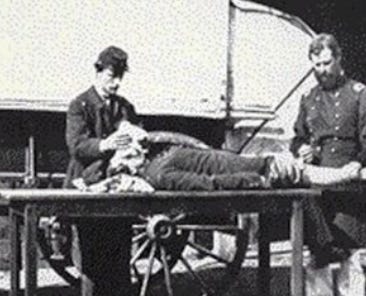 |
| The photo above taken by a commercial photographer in 2005 was just a small sample of the collection which was used in an article in a "Savannah Magazine" issue of that year. |
This is only a small sampling of Dr. Saleeby's Medical Antique equipment and book collection. Some 150 to 200 pieces of equipment collected over 20+ years is represented as a complete collection for loan/exhibit.
Questions? Please e-mail jpsaleeby@aol.com or call (912) 656-2297
Dr. Saleeby’s Medical Antique Collection Inventory
(estimated value along each listing)
Display Case (Glass top) Reproduction Antique inlay wood $250
Small Field Surgical Set (Ivory Handles, retractors, scissors, pick ups . 4 blades, 3 retractors) in leather box c.1860s $500
Ivory/bone tongue depressor c. 1900s $150
Victorian era morphine syringe and; two needles in box $100
Sharp and Dohme Ampoule Sodium Cacodylate 10cc for IV use in paper sheath $25
Circular pill box (cardboard) with “Choc. Opium) including 4 tablets $25
David and Geck Chromic Gut suture in glass ampoule $25
Cucurbitual - Cupping bowls (glass) c. 19th Century X 2 $28 each
Brass encased dual blade bloodletting Fleam early 19th Century $60
Sklar and co. stainless steel retractors X2 $15 each
Stainless Steel vaginal speculum $25
Stainless Steel 1905 spring-loaded needle holder $25
Bless-Moore Inst. Co. (St. Louise) Stainless Steel surgical kit c leather carrying case $350
A.F. and Co, wooden handled blood letter $200
Skull and Crossbones printing press dyes X2 $100 for both
B-D Erusto hypodermic needles Box and 5 needles $25
Stanley-Durit seamless rustless hypoderm needles box c 5 of 10 needles $20
Sklar Stainless oral/mouth retractor $150
OB/GYN suction/ D and C device with suction mount $25
Stainless Steel toothed needle holder with spring and ratchet catch $30
Urological Stainless Steel instrument – urethral probe with retractable blade $75
P and S 1900 spring loaded nasal speculum $50
Fannin.Dublin. Ivory handled ophthalmoscope in leather carrying case (England) $600
4 Glass medicine bottles 2x unlabeled , one labeled: Cocain Hydrochlor 5%, one labeled: Lapactic Pills Sharp and Dohme c contents and cork stopper. $200 for set.
Upright English Display Case on long legs Mahogany wood with mother of pearl and copper inlays c. late 1800s. $ 1200
Victorian era portable lab microscope with carrying box, assorted lenses and mirror $250
KNY-Scheerer (Germany) stainless steel suturing instrument $25
American Standard Haemacytometer with Levy counting chamber – Arthur H. Thomas Co. Phil USA (all components except rubber tubing which has deteriorated) with box $100
H and S 90 Civil War era dental pliers. $100
B-D Yale 1min. Becton Dickinson and Co. nurses oral thermometer with carrying tube and pin on. C. 1940s $150
Three assorted sounds/probes stainless steel $25 for set
Civil War era ebony handles spade shaped double edged bloodletting instrument $150
Civil War Mahogany Box with brass plate “Dr. Whiteford from JD 1864” Amputation Kit (single saw, 3 blades with ebony handles, 2 retractors, one pick up and Arnold and Sons (London) bone pliers (rongeurs), Tourniquet set (Atken). Sutures and 3.5 in. pins, Blades stamped with “Young” and have ebony handles. $6000 * could be either Alfred H. Whiteford, MD with NY 99th Infantry Naval Brigade and Union Coast Guard mustered out 1865 died 1873 or Aloysius X. Whiteford, MD died Feb 1901 allopath from Parkville, MD. Probably the former.
Glass syringe (Italy) c. 1960s $15
Books:
Analytical Compendium of Medical Science by John Neill, MD and F. G Smith, MD , 1866.
The Parasitic Amoebae of Man by C.F. Craig, MD 1911.
Merck’s Manual 1899 (reproduction).
PDR 1951 Original 5th Edition. $400 for all
==
J.B.Daniel retractor set (Ob/Gyn) stainless steel $40
Set of McIntosh D… dilators and sounds $25
Noyesbros and Cutler urological sound stainless steel $40
Dr. Forbes Specifications ATCo. (Germany) Bath Thermometer $50
Large leather doctors bag $25
D-B Direct Venous Pressure Apparatus $100
Allen and Hanburys (London) leather doctor’s case with 3 drawers filled with assorted hypodermic needles, pill boxes (circular) and instruments $500
Greco-Roman instruments 6 in all mounted in box frame c.100 AD $1500
Small Child’s crutches (one) c. late 1890s – early 1900s $100
Welch Allyn Co. #50 Opthal/Oto scope set in leather box c. 1950s $200
Capac Bin-Aural (London) $230
Klett Mfg. Co, Inc Bone drills and saw stainless steel electrical / orthopedic device (USA) in wooden box $200
Teaching Mannequin (nursing school) c. 1950’s $400
Gendron Wheel Chair Co. (Toledo OH) SN 69036N Convalescent Wheelchair with wicker seats and back (3-wheels) $500
Mahogany and Poplar/Pine Book case c. 1880s from Georgia Estate near Augusta, GA. $2000
Six calibrated baby bottles with metal rack c.1950s $40
Stainless Steel irrigator (urethral/ear) $75
Glass and Rubber breast pump c. 1950’s $50
Pioneers in the Fight against infectious disease plaque with medals Lilly andCo. Drug Rep gift. 7-medallions with Jenner, R[K]och, Ehrlich, Flemming, Leeuwenhoek, Pasteur, Lister $25
Otoscope , 1950s, American Cystscope-Makers, Inc. NY Wappler-E-Co. $100
Kittinger’s Drug Store cardboard pill box (rectangular) 1949 $30
2% Novutox Pharmaceutical Manuf. Co. (London) box + bottle only $50
Reusable syringe and needle graduated with glass tube $100
Stainless Steel tonsil extractor- KNY-Scheerer (Germany) c. 1950’s $25
Stainless Steel box and hypodermic needle with plunger (England) $75
Bottle of Compounded ASA, Phenacetin, Cod Phosph. With pills inside $50
Brown Bottle with Hyd-Crec Co. and pills inside $10
Bottle with Soneryl Gr 1.5 $10
Additional bottles $25
Stryphnnon Ribbon Gauze box $10
Pitocin ampoules Parke, Davis and Co. Old 5-units in box. $15
Glass with sealed cork, alcohol filled with many bands of suture (cat gut?) post-1880s $100
Alpha blades $10
Box of syringes $25
Old prescriptions c. 1919 almost 50 count $100 for all
Dr. Nelsons Improved Inhaler / porcelain $150
General Medicine 1925 Book $25
General medicine, ed. by George H. Weaver, Lawrason Brown, Robert B. Preble.
(26-16513) 7141 Who's who in American medicine, 1925.
Syphilis Book 1901 $25
Syphilis: its diagnosis and treatment, William Samuel Gottheil - 1901
CYSTOCATH SUPRAPUBIC DRAINAGE SYSTEM c. 1970s $10
Scarification device (brass) F.A.Koch and Co. NY $300
Merthiolate Swabs Lilly Old box with swabs $10
Powers and Anderson B-D Manometer c. 1950s $100
Trepanation surgical skull bore device c. post-1880 Pilling PA $250
Cover and bottle, Chamberlain’s colic relief and wind colic $25
Doctors pill box case leather, with 24 bottles some with pills varied medications post-1880s $250
Smith and Woodman Dispensing Chemists, St. Augustine FLA bottle $45
2 glass syringes with metal cap and plunger (Special Standard Glass) $200 for both
(one made in Italy)
Ampoule Mersalyl B. D. H. (London) with content $25
Small round cardboard pill box with 6 pills $20
Glass tabs Trinitrum vial $20
USA Medical Dept porcelain measure $40
Old Stethoscope bell only c.post-1880s $200
Glass eye c. 1880's $50
Metal urethral dilators X3 $50 for all
Chinese Stethoscope with diaphragm and bell interchangeable, rubber deteriorate c. 1960s $100
Autoclave container tin/porcelain with tray c. 1950s $100
12 Boxes of Hypodermic Needles various companies c. 1950’s $150 for all
Small pill box leather pocket case with small thin 7 glass pill vials, some with Digitalin, Strychnine sulfate, Morphine and Atropine, other. $200
Old set of OB/GYN forceps $250
Cat Gut Sutures in breakable vials X2 $100 for both
Speculums stainless steel c. 1950s X2 $100 each
Old Magill like forceps (Sharp and Smith) c. 1950s $100
Military Preventive Medicine 3rd Edition 1938 Book $30
Essentials of Electro-cardiography 1937 Book $30
Cellular Toxins 1902 4th Edition Book $50
Vaporizer- Turpo Electric in Box $125
Box with hypodermic needle and plungers for Rabies Vaccine $50
Dental Pliers c. pre-1880's x 2 $75 each
Sterogyl-15 injectable Roussel labs Lmt (London) one ampoule remains $50
Manual of Diseases of the Nose and Throat 2nd Edition 1901 Book $45
A MANUAL OF DISEASES OF THE NOSE AND THROAT By CORNELIUS GODFREY COAKLBY, AM, Lea Brothers & Co., 1901.
American Medical Biography 1828 Book $150
by James Thacher, Richardson & Lord, 1828
MCG Year Book 1966, 1974, 1976, 1991 $100 for all
Wrist support aluminum mid-1970's $30
Cystoscope – Bransford Lewis Universal Cysto. C. 1950’s in box $250
X-ray tube from OLD x-ray machine 1980s. $50
Old First Aid Kit with supplies 1970s. $30
Assorted Instruments OB/GYN X8 $200 for all
Effingham Co. Hospital Gift Plate with medical motif $25
Auto badge enameled “MD” with Cadusa and Cross (c. 1950s) $75
Hot Bottle/ test-tube bath (for laboratory) A.S. Aloe Co. c. post-1880s $300
Burdick ECG Machine EK III – 1960-1970s with reflex device (bogus) $100
Three different Porcelain/ clay figureens of Doctors (Mickey Mouse, Elf and Contemporary Collectible Artist) $200 for all three
Four Antique Anatomical Prints (Dissections) from Old English Text c. post-1880 matted and framed $800/set
Three bottles (varied sizes) Dr. Tichenor's Antiseptic $100 for all three.
Two framed collections of Medical Related United Postage Stamps $150/both sets
----






